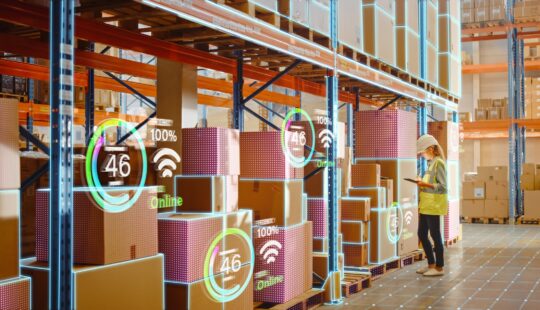At this year’s virtual Hannover Messe exhibition, SAP will show how Industry 4.Now can help make supply chains more flexible and dynamic, including through the use of the Industrial Internet of Things (IIoT).
“Many of our customers have seen their global supply chains take on a tremendous level of complexity,” says Dominik Metzger, head of Product Management, Manufacturing, and Industrial IoT at SAP. Those operating in production industries typically find themselves enmeshed in an intricate web of international suppliers and sub-suppliers. “That’s why plenty of companies are really struggling with disruptions,” Metzger explains. “Some of them have to do with COVID-19, but others have been apparent since before the pandemic.”
In terms of macroeconomic trends, the introduction of significant trade tariffs between China and the U.S. as well as the post-Brexit EU/UK Trade and Cooperation Agreement have rattled the established structures of many organizations.
“For that reason, if anything is a top priority for our customers – right now and after the pandemic – it is measures that lower costs and boost productivity in efficient ways,” Metzger says. “For those of us at SAP, the core question is: How can we leverage our innovative technologies to help our customers automate their processes?”
At the virtual Hannover Messe 2021 exhibition, SAP plans to unveil an array of new functions and applications that are set to make industrial process data usable all along the value chain starting in the second quarter.
“That includes data generated during manufacturing, maintenance, logistics, and so on, which needs to be integrated deep within SAP applications,” Metzger shares. Value cannot be created for companies with data alone; it also has to be analyzed in a business context. “That context lies in SAP systems – in our intelligent suite, our industry cloud, and our manufacturing and logistics solutions.”
Supplying Materials Automatically with IoT, Robotics, and Edge Computing
Metzger’s product management team has put together an IIoT portfolio that enables customers to fully automate their resupply and stock removal processes in SAP S/4HANA, to name just two examples. This is made possible by robotics, the digitalization of intralogistics processes, and an intelligent framework of rules that derives potential actions from real-time data.
In assembly line manufacturing, things like forklifts and manual transport systems are needed to retrieve materials for subsequent installation. Areas like these are where companies often implement the ‘kanban’ process, which involves supplying materials exactly where production and assembly employees need them on the line.
“Sensors are now being built into these kanban bins in order to ‘connect’ the materials,” Metzger explains. “A sensor can tell when the weight of its bin has fallen below a certain threshold, which is when more materials are automatically procured to resupply the bin.”
Meanwhile, an intelligent, cloud-based system of rules interprets the sensor data to determine when actions should be triggered in specific business processes and applications. Systems like SAP S/4HANA, SAP Digital Manufacturing Cloud, and SAP Predictive Asset Insights are highly integrated into the rules to help ensure that the right processes are automatically activated at the right time. Procedures pertaining to kanban, the posting of goods, and quality assurance are just a few pertinent examples.
“We refer to this combination of IoT and SAP Edge Services as ‘Industrial IoT’ because we’re using IoT data in an industrial context,” Metzger says.
In a further innovation, autonomous guided vehicles (AGVs) are responsible for retrieving materials instead of forklift drivers. Metzger describes this fully automated approach to supplying assembly lines and carrying away finished products as a “best-in-class” logistics process, but one that only works when completely integrated between SAP systems for manufacturing execution (MES) and warehouse management.
These new functions are designed to be used in the context of SAP Digital Manufacturing Cloud, where they can be implemented and employed seamlessly thanks to the integration of SAP Manufacturing solution systems and others for logistics.
Lower Implementation Costs Through Standardization
According to a study that SAP conducted with the MPI Group, customers tested these productivity-boosting innovations at specific plants and warehouses in 2020, but have not yet rolled them out more broadly in many cases.
“That’s because until now, the integration of operational technology like AGVs or machines, sensors, and other equipment wasn’t standardized very well in business software,” Metzger explains. “This meant that such projects involved a relatively large amount of implementation effort, and thus higher costs – which led to something of a catch-22 with regard to the fundamental idea of reducing costs and increasing productivity.”
In the meantime, however, SAP has put much of its focus on integrating automation technologies into industry standards like the OPC Unified Architecture and on implementing the administration shell.
SAP Relies on Cloud-Edge Architecture to Reduce Costs
“Over the last six or seven years, we’ve invested a huge amount of effort in lowering the total cost of ownership of these implementations so that customers can operate them at scale. Along with standardization, the main thing that’s helping us here is our own technological innovation in terms of cloud-edge architecture,” Metzger says. In the past, the fact that SAP hardware infrastructure had to be set up at every plant was another reason why implementing new solutions was expensive.
“These days, however, all these processes run in the cloud,” Metzger continues. This means that it takes just one data center to control processes like warehouse robotics, digital manufacturing, or IIoT at 100 plants or more.
“When you’re dealing with automation processes in particular, you can’t afford to have an Internet connection fail for a few seconds,” Metzger says. “It was for high-availability scenarios like these that we introduced SAP Digital Manufacturing Cloud for edge computing.”
This involves an edge device – basically a small-scale server – that helps ensure that mission-critical processes always keep running at a plant. Instead of being implemented anew at each facility, these processes are configured centrally in the cloud for each specific plant and run at the edge in a container at the plant.
SAP Edge Services and other IoT offerings from the company enable customers to turn use cases like these into reality. “It gives you the best of both worlds,” Metzger says. “It significantly improves your ability to scale up thanks to cloud computing, all while reducing your total cost of ownership. Plus, edge computing gives you the degree of robustness you need to control mission-critical processes.”
In addition, auto ID technology is to be offered as a new function in SAP Edge Services and IoT solutions from SAP. This technology makes it possible to automatically associate the movement of a physical object with a specific process step. “Real-time status updates like these are a big step forward in terms of supply chain reliability,” Metzger says. “This way, companies can make sure they’re always available to their customers and able to adapt to bottlenecks around the world.”
To find out more about how IIoT can help your company reduce costs and increase its productivity, register here for the virtual Hannover Messe exhibition, scheduled for April 12–16, 2021.



